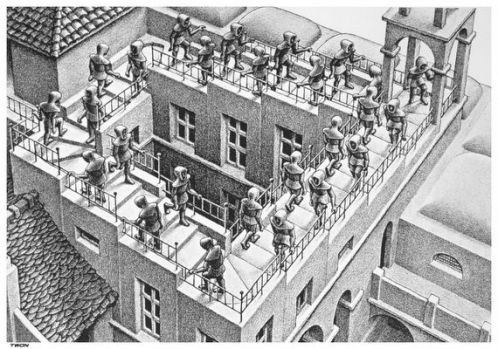September 20, 2010
A proliferation of virtual catatonic bodies, or why Inception is not Escheresque
(This originally appeared in Dublin's Visual Artsts' News Sheet)

On the surface, Christopher Nolan’s Inception seems to be a very Escheresque film. At one point, one of the characters, Arthur, instructs another by using the example of “the Penrose stairs” which have the same impossible structure as Escher’s famous "Ascending and Descending".
Inception has many merits, but ultimately it isn’t actually very Escheresque. In his Gödel, Escher, Bach, Douglas Hofstadter argues that the defining characteristic of most of Escher’s signature images is the “strange loop” or “tangled hierarchy”. This is where a distinct hierarchy of levels is set up, only to be disrupted - as in "Ascending and Descending", we appear to go up and down levels but eventually find ourselves back at the same point.
In Inception, the different levels are constituted by dreams - which, in the reality of the film can be invaded by spies trying to raid the subject’s mind for business secrets. Blogger Carl Neville argues that each of these dream-levels corresponds with a different film genre: “Level one dream is basically The Bourne Identity … rainy, grey, urban. Level two is The Matrix, zero gravity fistfights in a modernist hotel, level three, depressingly, turns out to be a Seventies Bond film.”

In the ordinary phenomenon of the dream within dream, we appear to wake up, but in fact are still dreaming (it is worth noting here that this structure is somewhat stranger than its description makes it appear in that it is the first dream that retrospectively becomes the dream embedded within the second dream.) These dreams within dreams are a question of narrative sequence. One dream succeeds another, but then produces the (narrative) illusion of a different ontological level. This is analogous with the logic of what media theorists call “ret-con”, or retroactive continuity. Continuity is achieved by retroactively changing the status of what was previously taken for reality. (It’s no accident that the most famous example of ret-con - one whole season of Dallas being retroactively redefined as a dream sequence - involved dreaming.) Far from the second dream being really contained within the first, its whole existence depends upon the dissolution of the first. The appearance of different levels is a narrative effect generated by the retroactive continuity of the dream state. There is only one level of ‘real’ physical-causal dependence - the dream relies upon the body of the dreamer remaining asleep. (Which is partly why Lacan claimed that the goal of dreaming was to keep the dreamer asleep.)
But the dreams within dreams in Inception differ in at least two respects from this. Firstly, there is no time when someone wakes up from a previous dream and remembers it as a dream. Rather, the subjects just leap into another dreamspace. Nolan includes a scene explaining that this is how dreams work - we are always thrown into the middle of them. Secondly, Nolan produces a dream architecture in which there are multiple levels of real rather than apparent dependence. In Inception, each dream within a dream depends upon the dream one level up continuing in the background. To go down a level - to pass, for instance, from “Bourne Identity” level-1 dream to “Matrix” level-2 dream - the characters have to fall asleep in the first-level dream. In other words, Nolan expands what in ordinary dreaming is a two-tier structure (the sleeping body and the dream) into a potentially infinite regress. As they go down a level, each character acquires a new dream-body, but this avatar depends upon a virtual catatonic body one level up. The dream avatars at “Bond movie” dream level-3, then, can only continue to exist while the virtual catatonic bodies at level-1 and level-2 and their real physical bodies all remain asleep. In ordinary dreams, the physical body is effectively a level 0, and when something happens in/to the physical body, these physical/ neurological events are re-motivated by the dream as narrative shifts (hence the well-known phenomenon of alarm clocks becoming sirens in dreams and such like). Nolan’s proliferation of virtual catatonic bodies means that this translation of physical stimuli into dreamwork also proliferates, with each level acting as a quasi-physical level cause for what lies beneath it. The most obvious example of this in the film is the way that the tumbling of the van off a bridge at level-1 becomes converted into zero gravity at level-2.

So Inception has a well-formed hierarchy. But what stops the film being properly Escheresque is that the hierarchy is never disrupted. By contrast with David Cronenberg’s films Videodrome and Existenz, in which ostensibly embedded realities start to affect “ontologically superior” higher levels, the different reality levels in Inception remain securely delimited. Causality only runs one way - downward - from the higher to the lower levels. No doubt it is the linear demands of the action film that militate against the eerie impasses and uncanny topographies of the strange loop.
Posted by mark at September 20, 2010 04:57 PM | TrackBack